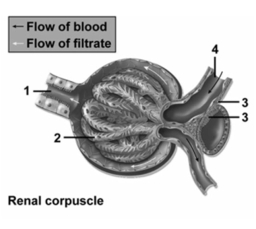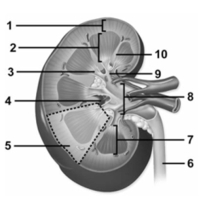Correct Answer

verified
Correct Answer
verified
Multiple Choice
Of the excretory organs that form during development,which one ultimately forms the adult kidney?
A) Mesonephros
B) Metanephros
C) Pronephros
D) Renanephros
E) Uretonephros
Correct Answer

verified
Correct Answer
verified
True/False
Coordinated movements of the microvilli in the proximal convoluted tubule assist in the propulsion of tubular fluid toward the nephron loop.
Correct Answer

verified
False
Correct Answer
verified
Multiple Choice
Which layer is not found in the wall of the ureter?
A) Adventitia
B) Muscularis
C) Mucosa
D) Submucosa
E) No exceptions;all layers are found in the wall of the ureter.
Correct Answer

verified
Correct Answer
verified
Multiple Choice
Urine formed in the pyramids must flow within the kidney to the ureter.Which structure is not part of the transport path within the kidney that carries urine to the ureter?
A) Renal sinus
B) Major calyx
C) Renal pelvis
D) Minor calyx
E) No exceptions;all choices transport urine.
Correct Answer

verified
Correct Answer
verified
Multiple Choice
An obstruction in the glomerulus would affect the flow of blood into the
A) renal artery.
B) proximal convoluted tubule.
C) efferent arteriole.
D) distal convoluted tubule.
E) afferent arteriole.
Correct Answer

verified
Correct Answer
verified
Multiple Choice
Filtration occurs because
A) the glomerulus is leaky.
B) the afferent arteriole is wider in diameter than the efferent arteriole.
C) the capillary wall is not completely ensheathed by the visceral layer of the glomerular capsule.
D) the filtration slits allow materials from the blood plasma to enter the capsular space.
E) All of the choices are correct.
Correct Answer

verified
Correct Answer
verified
Multiple Choice
The spongy urethra
A) is found only in males.
B) is the longest portion of the urethra.
C) is encased within the corpus spongiosum.
D) is lined proximally by pseudostratified columnar epithelium and distally by stratified squamous epithelium.
E) All of the choices are correct.
Correct Answer

verified
Correct Answer
verified
Multiple Choice
An adult human kidney typically contains ______ renal pyramid(s) .
A) 2 to 5
B) 8 to 15
C) 16 to 24
D) 1
E) 30 to 40
Correct Answer

verified
Correct Answer
verified
Multiple Choice
 -This figure shows a renal corpuscle.The two structures indicated by number 3 collectively form the
-This figure shows a renal corpuscle.The two structures indicated by number 3 collectively form the
A) Macula densa
B) Juxtaglomerular apparatus
C) Corticomedullary junction
D) Juxtamedullary junction
E) Vasa recta
Correct Answer

verified
B
Correct Answer
verified
Multiple Choice
Which is not correct regarding nephrons?
A) The renal corpuscle includes the glomerulus and the glomerular capsule.
B) The renal tubule is composed of the proximal convoluted tubule,nephron loop,and distal convoluted tubule.
C) The nephron is the functional filtration unit in the kidney.
D) Eighty-five percent of nephrons are cortical nephrons.
E) The renal corpuscle may be located in the renal cortex or renal medulla.
Correct Answer

verified
Correct Answer
verified
Multiple Choice
Place the regions of the nephron in the correct order for the process of urine formation. A: Capsular space of glomerulus B: Nephron loop C: Collecting duct D: Distal convoluted tubule E: Proximal convoluted tubule
A) a,c,b,e,d
B) e,d,b,a,c
C) b,e,c,d,a
D) b,d,c,e,a
E) a,e,b,d,c
Correct Answer

verified
Correct Answer
verified
Multiple Choice
 -This figure shows a frontal section of the kidney.Which number(s) indicate a renal papilla?
-This figure shows a frontal section of the kidney.Which number(s) indicate a renal papilla?
A) 2,7
B) 3
C) 6
D) 9
E) 10
Correct Answer

verified
Correct Answer
verified
Short Answer
The juxtaglomerular cells release the enzyme ______________ when the macula densa cells detect low blood volume or solute concentration.
Correct Answer

verified
Correct Answer
verified
Multiple Choice
 -This figure shows a renal corpuscle.What structure does number 4 indicate?
-This figure shows a renal corpuscle.What structure does number 4 indicate?
A) Efferent arteriole
B) Renal artery
C) Peritubular capillary
D) Afferent arteriole
E) Efferent venule
Correct Answer

verified
Correct Answer
verified
Multiple Choice
 -This figure shows a renal corpuscle.What structure does number 1 indicate?
-This figure shows a renal corpuscle.What structure does number 1 indicate?
A) Distal convoluted tubule (DCT)
B) Collecting duct
C) Nephron loop
D) Proximal convoluted tubule (PCT)
E) Papillary duct
Correct Answer

verified
Correct Answer
verified
Multiple Choice
Urine flow from the renal pelvis to the urinary bladder is produced by
A) ciliary action in the renal pelvis.
B) suction from the urinary bladder.
C) peristalsis of the ureters.
D) hydrostatic pressure from the small intestine.
E) contraction of the detrusor muscle.
Correct Answer

verified
Correct Answer
verified
Multiple Choice
How does aldosterone affect urine formation?
A) Increases the reabsorption of sodium and water by the distal convoluted tubule
B) Increases the secretion of sodium and potassium ions from the nephron loop
C) Decreases the reabsorption of sodium and chloride ions by the distal convoluted tubule
D) Increases the secretion of water by all regions of the renal tubule
E) Decreases the reabsorption of electrolytes,glucose,and plasma proteins by the proximal convoluted tubule
Correct Answer

verified
A
Correct Answer
verified
Short Answer
The ball of capillaries in the renal corpuscle is called the ________________.
Correct Answer

verified
Correct Answer
verified
Multiple Choice
Which is not of ureteric bud origin?
A) Renal pelvis
B) Collecting duct
C) Minor calyx
D) Distal convoluted tubule
E) Ureter
Correct Answer

verified
Correct Answer
verified
Showing 1 - 20 of 73
Related Exams